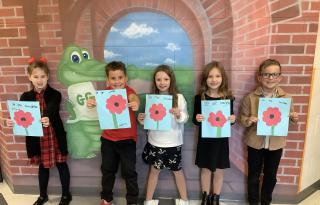Posted: October 12, 2016
Mme Lockerbie
Posted: October 11, 2016
Listen and Repeat Numbers to 100
Posted: October 6, 2016
This month, we continue our mathematics unit on increasing and decreasing patterns. Recognizing and analyzing patterns is an important part of mathematical thinking. Patterning concepts lead to work with algebra in higher grades. In this unit, your child will:
• Identify, extend, create, and compare increasing patterns.
• Identify, extend, create, and compare decreasing patterns.
• Find pattern rules. • Display number patterns on hundred charts.
• Use patterns to solve problems.
Patterns can be found all around us. Encourage your child to look for patterns around the home and talk about them. Here are some suggestions for activities you can do at home: • Look for patterns in your family’s activities as marked on a calendar at home. What activities do you do daily? Twice a week? Every week? • Use small objects like buttons or coins to make patterns that grow or shrink. Encourage your child to describe and extend the patterns. • Count collections of nickels and dimes by 5s and by 10s. Count pennies by 2s. *** We will continue to work on numbers from 0-100 in order to be better prepared for our 2nd unit: Numeration. We will also continue to work on Bar Graphs and Pictographs. Mme Lockerbie
Posted: September 29, 2016
Posted: September 25, 2016
Les nombres 20 -50
Posted: September 25, 2016
Happy Monday! This week in Math we will continue to work on patterns and our numbers, up to 50.There are several web links on my teacher page to practice the numbers in French. We will also learn how to take a survey using tally marks, and how do make a bar graph and picto-graph. For example, students will ask their friends: "Quelle est ta couleur préférée? "(What is your favourite colour?). Then, they will tally the answers and colour in the bar graph. In French literacy, we will continue to work on our first unit called "Je suis unique" (I'm unique). Students coontinue to learn vocabulary to describe themselves and their friends. They will also learn to express their preferences and dislikes. We continually review learned language structures, adding to the list weekly. Here are a few new oral structures for this week:
Qu’est-ce que tu aimes? (J’aime mon chien).
Qu’est-ce que tu aimes à l’école? (À l’école, j’aime la musique).
Qu’est-ce que tu n’aimes pas? (Je n’aime pas la pluie).
Qu’est-ce que tu adores? (J’adore les souliers).
We will continue to learn a few new songs/ poems around this theme. Students will also continue to read thematic books with a partner on a daily basis. These books will be sent home as homework this week. Have a great week everyone! Bonne semaine!
Posted: September 23, 2016
Posted: September 19, 2016
French Sight Words 1
Great video to help students read and spell French sight words. Students can practice saying (repeating) the words out loud. We will practice spelling these words all year.
Posted: September 19, 2016
In French Language Arts, we have reviewed the questions from last week and are learning more questions/oral structures such as :
Où habites-tu? J'habite à Miramichi.
Quelle couleur sont tes cheveux? Mes cheveux sont....
Quelle couleur sont tes yeux? Mes yeux sont...
In reading (lecture), we are working on the vowel sounds and we are reading simple books related to the school vocabulary seen in class. We have also learned a few new songs and continue to learn classroom vocabulary. Students have been writing each day. They are writing about themselves (Moi). In Math, we have been working on our numbers from 0-30. We are also ordering and comparing numbers (16 est plus grand que 10. 3 est plus petit que 12),
Have a great week!
Mme Lockerbie!
Posted: September 16, 2016
Each Friday, students have a spelling test on the words studied in class during "Word Work". Presently, they are working on sight words. Students practice their 6 words in class through daily hands-on activities. They do not have to study the words at home. If you would like to go over our spelling words with your child at home, you may do so.
*** The 6 spelling words are included on the students' reading sheet. The words are written in the square box with a star in the corner.


























